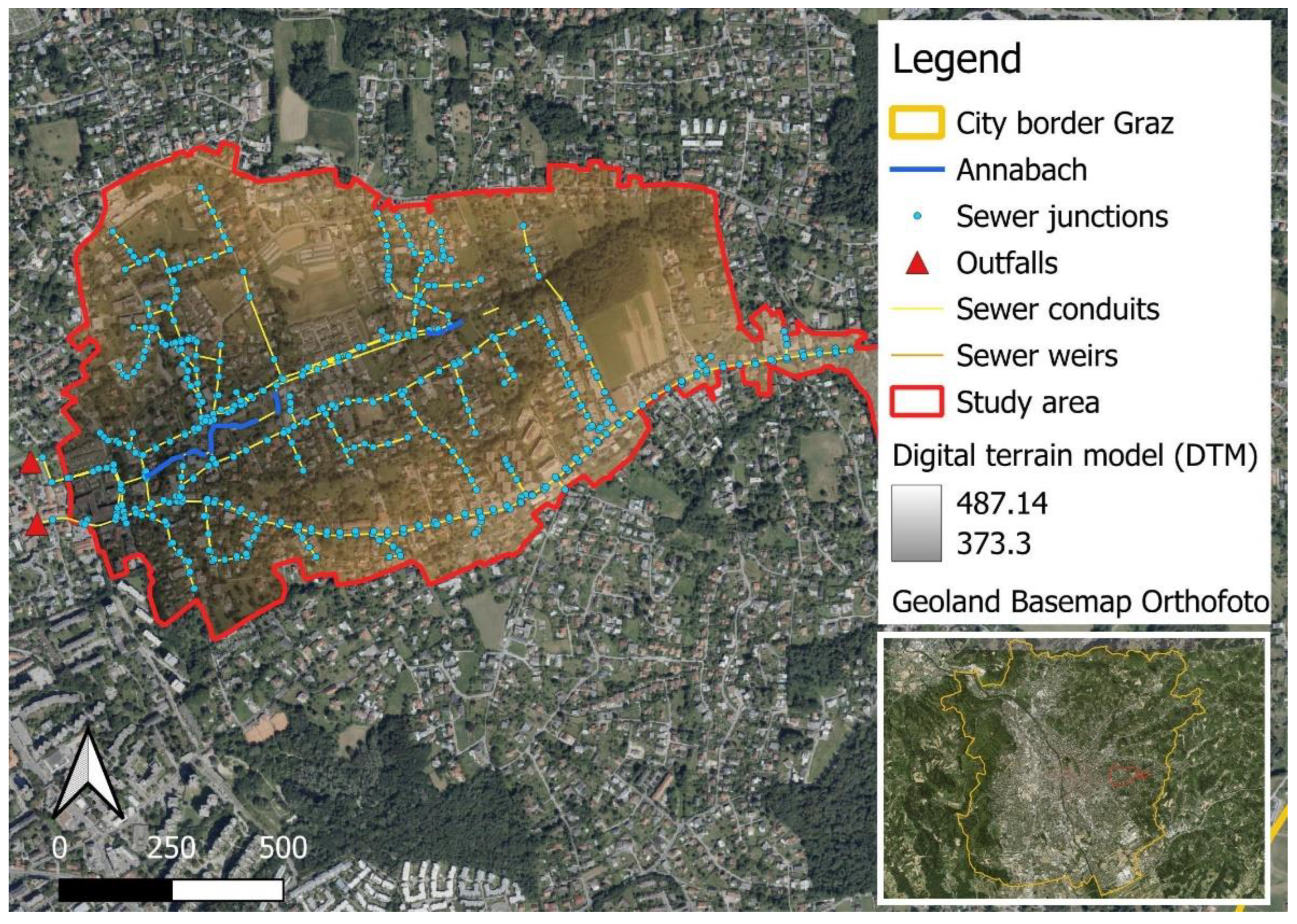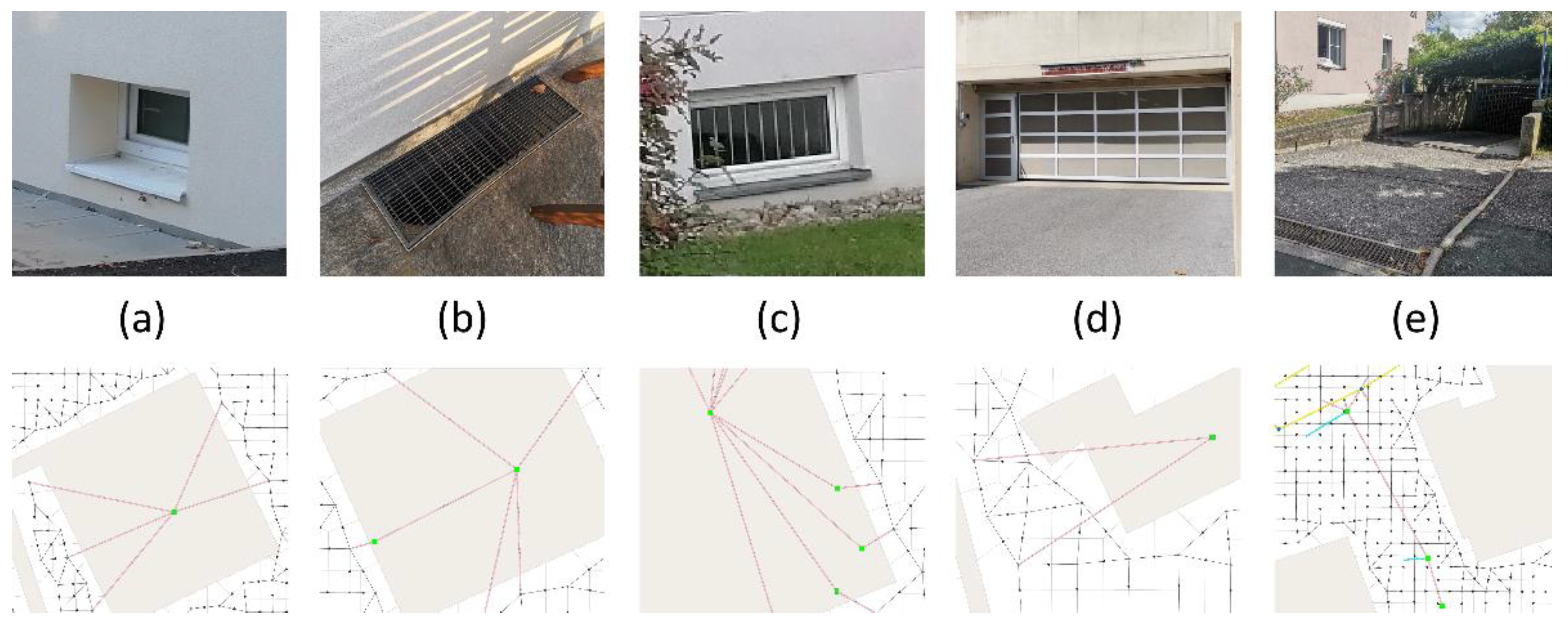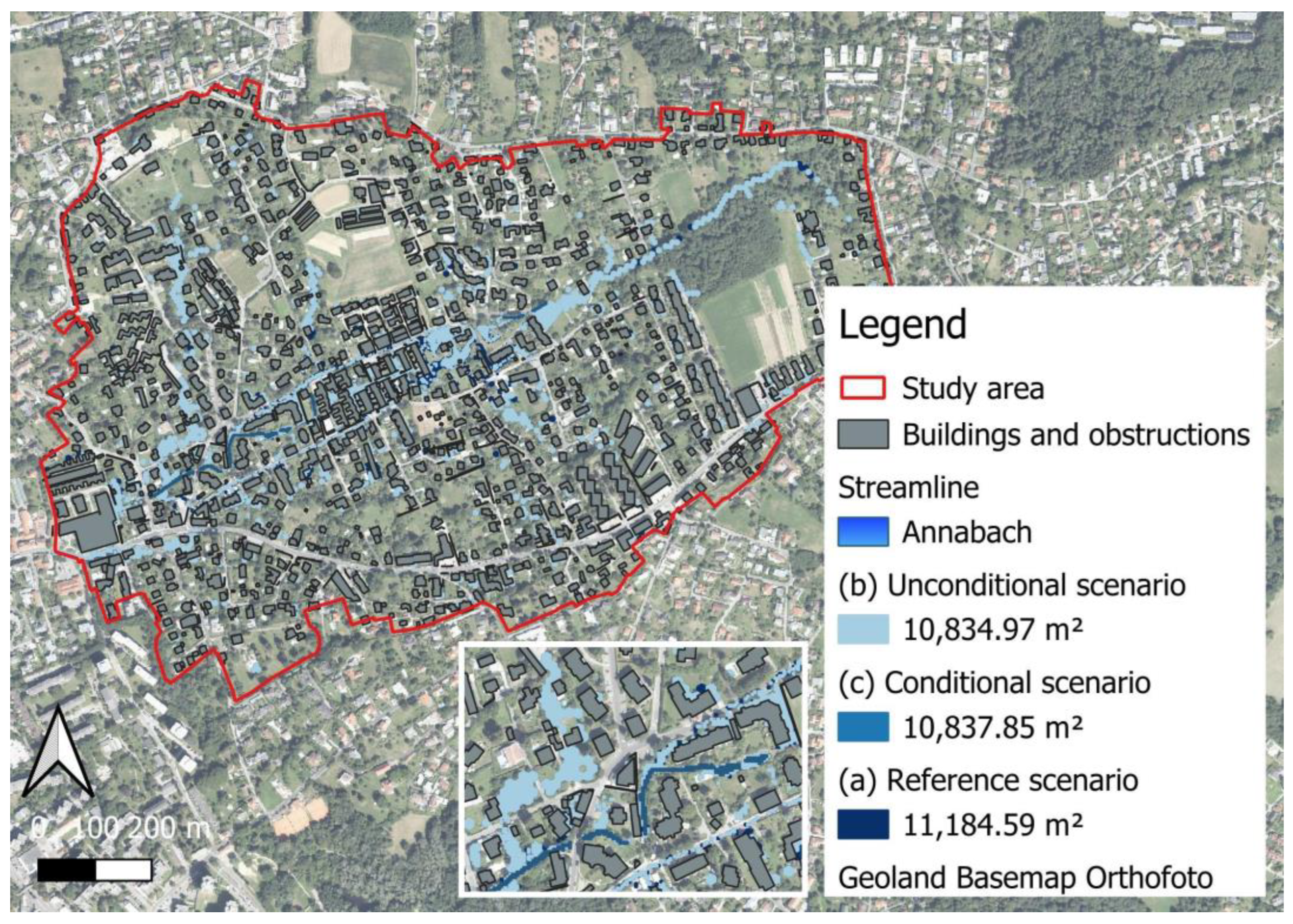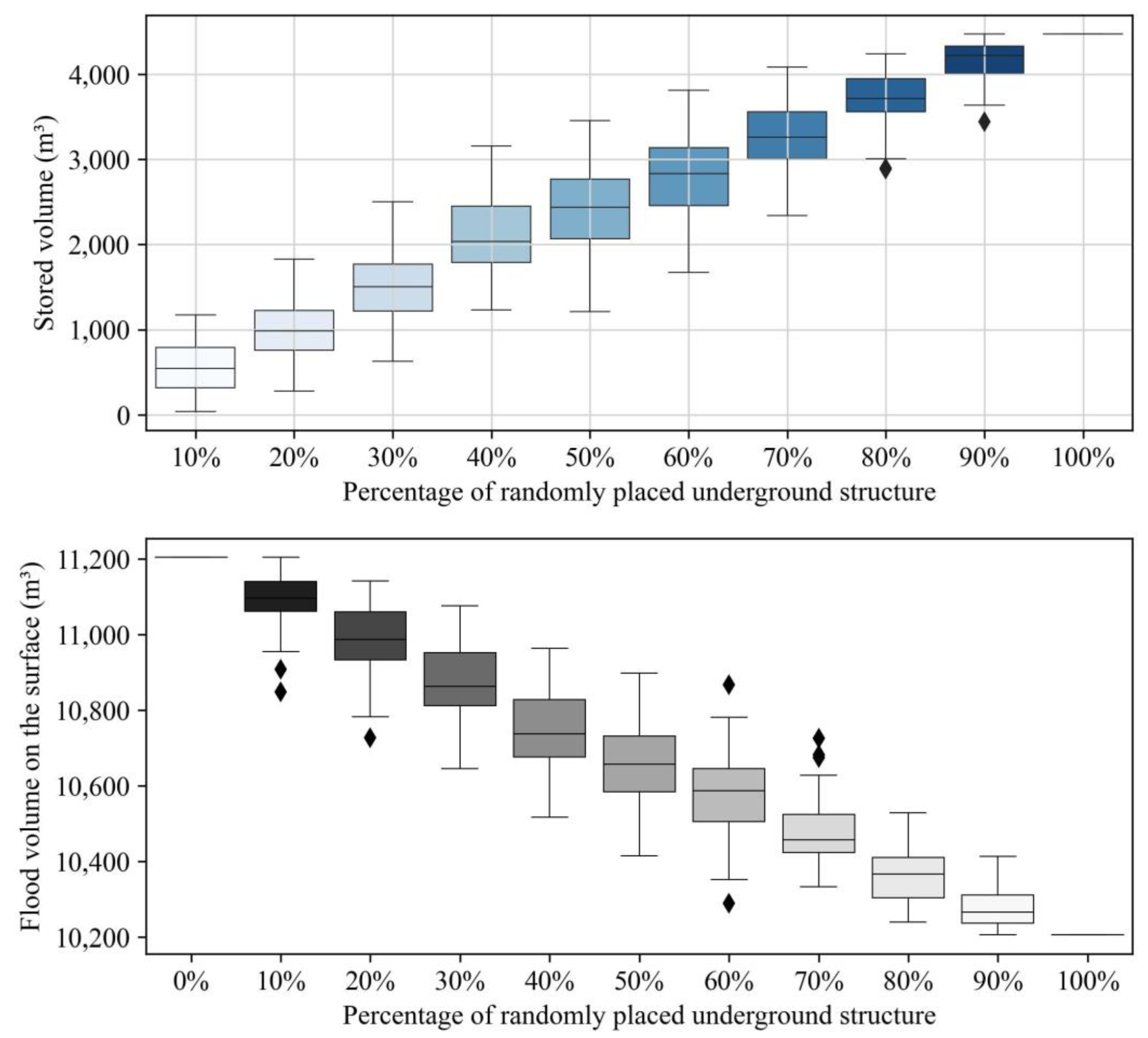The Impact of Underground Structures on Urban Flood Models
Abstract
:1. Introduction
2. Materials and Methods
2.1. Study Site
2.2. Data Requirements
2.3. Modelling Approach
- Condition 1: Water level at the connected mesh node is greater than 0.05 m (including the inlet offset).
- Condition 2: Velocity in the incoming mesh conduits is greater than 0.2 m/s.
- Stored volume and number of flooded structures: This section compared the number of flooded structures and flood volume stored in the basements and garages. A structure was considered to be affected when water entered the underground structure, and this number was counted as the sum of all flooded structures. The stored flood volume was calculated as the sum of the maximum water volume in each flooded structure at the end of the event. Reference scenario (a) was ignored here, as there were no underground structures and, therefore, no stored volume in any structure.
- Reduction in surface flooded area: A comparison of the surface flooded area was performed for all three scenarios and all three events. An area was considered flooded if the water level exceeded 0.05 m.
2.4. Sensitivity Analysis
3. Results and Discussion
3.1. Impact of Underground Structures
3.1.1. Stored Volume and the Number of Flooded Structures
3.1.2. Reduction of Flood Area on the Surface
3.2. Sensitivity Analysis
3.2.1. Sensitivity Analysis of the Location and Number of Underground Structures
3.2.2. Manual Sensitivity Analysis of the Control Strategy Parameters
4. Conclusions
Author Contributions
Funding
Data Availability Statement
Conflicts of Interest
References
- Moatti, J.-P.; Thiébault, S. The Mediterranean Region under Climate Change: A Scientific Update; IRD Éditions: Marseille, France, 2016; ISBN 978-2-7099-2219-7. [Google Scholar]
- Berndtsson, R.; Becker, P.; Persson, A.; Aspegren, H.; Haghighatafshar, S.; Jönsson, K.; Larsson, R.; Mobini, S.; Mottaghi, M.; Nilsson, J.; et al. Drivers of Changing Urban Flood Risk: A Framework for Action. J. Environ. Manag. 2019, 240, 47–56. [Google Scholar] [CrossRef] [PubMed]
- Papalexiou, S.M.; Montanari, A. Global and Regional Increase of Precipitation Extremes Under Global Warming. Water Resour. Res. 2019, 55, 4901–4914. [Google Scholar] [CrossRef]
- O’Donnell, E.; Thorne, C. Drivers of Future Urban Flood Risk. Philos. Trans. R. Soc. A Math. Phys. Eng. Sci. 2020, 378, 20190216. [Google Scholar] [CrossRef] [PubMed]
- Kleidorfer, M.; Tscheikner-Gratl, F.; Vonach, T.; Rauch, W. What Can We Learn from a 500-Year Event? Experiences from Urban Drainage in Austria. Water Sci. Technol. 2018, 77, 2146–2154. [Google Scholar] [CrossRef] [PubMed]
- ZAMG. Storm Chronicle (in German: Unwetterchronik)—ZAMG. Available online: https://www.zamg.ac.at/cms/de/klima/klima-aktuell/unwetterchronik?jahr=2018&monat=6 (accessed on 12 September 2022).
- Davies, R. Austria and Germany—More Deadly Flash Floods after Heavy Rain—FloodList. Available online: https://floodlist.com/europe/austria-germany-bavaria-floods-july-2021 (accessed on 20 September 2022).
- FloodList—Europe. Available online: https://floodlist.com/europe (accessed on 19 January 2023).
- Tsakiris, G.P.; Loucks, D.P. Adaptive Water Resources Management under Climate Change: An Introduction. Water Resour. Manag. 2023, 37, 2221–2233. [Google Scholar] [CrossRef]
- Bournas, A.; Baltas, E. Analysis of Weather Radar Datasets through the Implementation of a Gridded Rainfall-Runoff Model. Environ. Process. 2023, 10, 7. [Google Scholar] [CrossRef]
- Freddy, V.; Saidi, M.E.; Douvinet, J.; Fehri, N.; Nasrallah, W.; Menad, W.; Mellas, S. Sub-Chapter 3.4.1. Urbanization and Land Use as a Driver of Flood Risk. In The Mediterranean Region under Climate Change; IRD Éditions: Marseille, France, 2016; pp. 563–575. [Google Scholar] [CrossRef]
- Dutal, H. Determining the Effect of Urbanization on Flood Hazard Zones in Kahramanmaras, Turkey, Using Flood Hazard Index and Multi-Criteria Decision Analysis. Environ. Monit. Assess. 2022, 195, 92. [Google Scholar] [CrossRef]
- Ashley, R.M.; Balmforth, D.J.; Saul, A.J.; Blanskby, J.D. Flooding in the Future—Predicting Climate Change, Risks and Responses in Urban Areas. Water Sci. Technol. 2005, 52, 265–273. [Google Scholar] [CrossRef]
- Henonin, J.; Russo, B.; Mark, O.; Gourbesville, P. Real-Time Urban Flood Forecasting and Modelling—A State of the Art. J. Hydroinform. 2013, 15, 717–736. [Google Scholar] [CrossRef]
- Chang, T.-J.; Wang, C.-H.; Chen, A.S. A Novel Approach to Model Dynamic Flow Interactions between Storm Sewer System and Overland Surface for Different Land Covers in Urban Areas. J. Hydrol. 2015, 524, 662–679. [Google Scholar] [CrossRef]
- GebreEgziabher, M.; Demissie, Y. Modeling Urban Flood Inundation and Recession Impacted by Manholes. Water 2020, 12, 1160. [Google Scholar] [CrossRef]
- Dong, B.; Xia, J.; Zhou, M.; Deng, S.; Ahmadian, R.; Falconer, R.A. Experimental and Numerical Model Studies on Flash Flood Inundation Processes over a Typical Urban Street. Adv. Water Resour. 2021, 147, 103–824. [Google Scholar] [CrossRef]
- Nielsen, R.; Thorndahl, S. Sensitivity Analysis of an Integrated Urban Flood Model. In New Trends in Urban Drainage Modelling; Mannina, G., Ed.; Springer International Publishing: Cham, Switzerland, 2019; pp. 723–728. [Google Scholar]
- Starl, H. Hillside water modeling and its possibility of estimating potential hazards for buildings (in German: Hangwassermodellierungen und deren Möglichkeit zur Abschätzung von potenziellen Gefährdungen für Gebäude). Bautechnik 2020, 97, 255–267. [Google Scholar] [CrossRef]
- Bulti, D.T.; Abebe, B.G. A Review of Flood Modeling Methods for Urban Pluvial Flood Application. Model. Earth Syst. Environ. 2020, 6, 1293–1302. [Google Scholar] [CrossRef]
- Teshome, M. A Review of Recent Studies on Urban Stormwater Drainage System for Urban Flood Management. Preprints 2020, 2020100295. [Google Scholar] [CrossRef]
- Reinstaller, S.; Krebs, G.; Pichler, M.; Muschalla, D. Identification of High-Impact Uncertainty Sources for Urban Flood Models in Hillside Peri-Urban Catchments. Water 2022, 14, 1973. [Google Scholar] [CrossRef]
- Leitão, J.P.; Boonya-Aroonnet, S.; Prodanović, D.; Maksimović, Č. The Influence of Digital Elevation Model Resolution on Overland Flow Networks for Modelling Urban Pluvial Flooding. Water Sci. Technol. 2009, 60, 3137–3149. [Google Scholar] [CrossRef]
- Bellos, V. Ways for Flood Hazard Mapping in Urbanised: A Short Literature Review. Water Util. J. 2012, 4, 25–31. [Google Scholar]
- Bellos, V.; Tsakiris, G. Comparing Various Methods of Building Representation for 2D Flood Modelling In Built-Up Areas. Water Resour. Manag. 2015, 29, 379–397. [Google Scholar] [CrossRef]
- Deletic, A.; Dotto, C.B.S.; McCarthy, D.T.; Kleidorfer, M.; Freni, G.; Mannina, G.; Uhl, M.; Henrichs, M.; Fletcher, T.D.; Rauch, W.; et al. Assessing Uncertainties in Urban Drainage Models. Phys. Chem. Earth Parts A/B/C 2012, 42–44, 3–10. [Google Scholar] [CrossRef]
- Wang, X.; Hou, J.; Li, B.; Chai, J.; Wang, J.; Zhang, W. Study for Underpass Inundation Process Caused by Heavy Storm Using High-Resolution Urban Flood Model. Water Resour. Manag. 2022, 36, 3965–3980. [Google Scholar] [CrossRef]
- German Association for Water, Wastewater and Waste (DWA). Risk Management (in German: Risikomanagement); DWA-M119 (11/2016); DWA: Hennef, Germany, 2016. [Google Scholar]
- Sandink, D.; Binns, A.D. Reducing Urban Flood Risk through Building- and Lot-Scale Flood Mitigation Approaches: Challenges and Opportunities. Front. Water 2021, 3, 689202. [Google Scholar] [CrossRef]
- Liu, L.; Sun, J.; Lin, B.; Lu, L. Building Performance in Dam-Break Flow—An Experimental Study. Urban Water J. 2018, 15, 251–258. [Google Scholar] [CrossRef]
- Sturm, M.; Gems, B.; Keller, F.; Mazzorana, B.; Fuchs, S.; Papathoma-Köhle, M.; Aufleger, M. Experimental Analyses of Impact Forces on Buildings Exposed to Fluvial Hazards. J. Hydrol. 2018, 565, 1–13. [Google Scholar] [CrossRef]
- Mignot, E.; Camusson, L.; Riviere, N. Measuring the Flow Intrusion towards Building Areas during Urban Floods: Impact of the Obstacles Located in the Streets and on the Facade. J. Hydrol. 2020, 583, 124–607. [Google Scholar] [CrossRef]
- Pritsis, S.; Naves, J.; Del Puerto, X.; Deltsidis, N.; Cea, L.; Bermúdez, M.; Papakonstantis, I.; Puertas, J.; Sylaios, G.; Anta, J.; et al. Houses as Reservoirs in Urban Flood Modelling—Abstract Conference NOVATECH. 2023. Available online: https://www.novatech2023.org/ (accessed on 19 July 2023).
- Shettar, A.S.; Keshava Murthy, K. A Numerical Study of Division of Flow in Open Channels. J. Hydraul. Res. 1996, 34, 651–675. [Google Scholar] [CrossRef]
- Weber, L.J.; Schumate, E.D.; Mawer, N. Experiments on Flow at a 90° Open-Channel Junction. J. Hydraul. Eng. 2001, 127, 340–350. [Google Scholar] [CrossRef]
- Gems, B.; Mazzorana, B.; Hofer, T.; Sturm, M.; Gabl, R.; Aufleger, M. 3D-Hydrodynamic Modelling of Flood Impacts on a Building and Indoor Flooding Processes. Nat. Hazards Earth Syst. Sci. 2016, 16, 1351–1368. [Google Scholar] [CrossRef]
- CCCA Climate Change Centre Austria. Climate State Report (in German: Klimastatusbericht). Available online: https://ccca.ac.at/wissenstransfer/klimastatusbericht/klimastatusbericht-2020 (accessed on 8 February 2023).
- Maier, R.; Krebs, G.; Pichler, M.; Muschalla, D.; Gruber, G. Spatial Rainfall Variability in Urban Environments—High-Density Precipitation Measurements on a City-Scale. Water 2020, 12, 1157. [Google Scholar] [CrossRef]
- James, R.; Finney, K.; Perera, N.; James, B.; Peyron, N. SWMM5/PCSWMM Integrated 1D-2D Modeling. Fifty Years of Watershed Modeling—Past, Present and Future. Donigian, A.S., Field, R., Baker, M., Jr., Eds.; ECI Symposium Series. 2013. Available online: https://dc.engconfintl.org/watershed/ (accessed on 4 December 2023).
- Abdelrahman, Y.T.; Moustafa, A.M.E.; Elfawy, M. Simulating Flood Urban Drainage Networks through 1D/2D Model Analysis. J. Water Manag. Model. 2018, 26, C454. [Google Scholar] [CrossRef]
- Reinstaller, S.; Krebs, G.; Muschalla, D. Hazard Assessment of Pluvial Flooding in Urban Areas under Consideration of Fluvial Flooding. In Proceedings of the Interpraevent, Virtual, 31 May 2021. [Google Scholar]
- Simperler, L.; Kretschmer, F.; Ertl, T. A Methodical Framework for Analysing the Cause of Urban Pluvial Flooding in a Hillside Settlement. Water Sci. Technol. 2019, 79, 1798–1807. [Google Scholar] [CrossRef] [PubMed]
- CHI. Homepage CHI. Available online: https://www.chiwater.com/Home (accessed on 7 August 2023).
- Gironás, J.; Roesner, L.; Rossman, L.; Davis, J. A New Applications Manual for the Storm Water Management Model (SWMM). Environ. Model. Softw. 2010, 25, 813–814. [Google Scholar] [CrossRef]
- Rossman, L.A. Storm Water Management Model User’s Manual Version 5.1; EPA/600/R-05/040; Environmental Protection Agency: Washington, DC, USA, 2004. Available online: https://nepis.epa.gov/Exe/ZyPURL.cgi?Dockey=P100ERK4.txt (accessed on 17 March 2022).
- Municipal Agency NRW. Guideline for Municipal Heavy Rain Risk Management in Baden-Württemberg (in German: Leitfaden Kommunales Starkregenrisikomanagement in Baden-Württemberg). Available online: https://pudi.lubw.de/detailseite/-/publication/47871 (accessed on 28 November 2023).
- McDonnell, B.; Ratliff, K.; Tryby, M.; Wu, J.; Mullapudi, A. PySWMM: The Python Interface to Stormwater Management Model (SWMM). J. Open Source Softw. 2020, 5, 2292. [Google Scholar] [CrossRef] [PubMed]





| Utilised Information/Data | Data | Source |
|---|---|---|
| Calibrated model used for including the underground structures 1D | 1D/2D model in SWMM | Reinstaller et al. [22] |
| Precipitation (1 min resolution) | 4 August 2020, 13 August 2020, 30 July 2021 | Graz city measurement network (GCMN) [38] |
| Identification of underground structures (Assumptions have been made for information that could not be obtained.) | Google Earth | |
| Site visits | Own experience | |
| Information sheet | Document provided by the city council “Building and Facilities Authority” of Graz |
| Max. stored volume within the underground structures (m3) | |||
| 30 July 2021 | 13 August 2020 | 4 August 2020 | |
| (b) Unconditional scenario | 2539 | 1193 | 423 |
| (c) Conditional scenario | 2378 | 1134 | 441 |
| Number of flooded underground structures | |||
| 30 July 2021 | 13 August 2020 | 4 August 2020 | |
| (b) Unconditional scenario | 56 | 42 | 27 |
| (c) Conditional scenario | 48 | 36 | 23 |
| Percentage of Buildings with US (%) | Max. Number | Min. Number | Median |
|---|---|---|---|
| 10 | 15 | 3 | 11 |
| 20 | 24 | 10 | 18 |
| 30 | 34 | 16 | 25 |
| 40 | 41 | 26 | 34 |
| 50 | 50 | 31 | 40 |
| 60 | 55 | 38 | 45 |
| 70 | 61 | 46 | 54 |
| 80 | 68 | 55 | 62 |
| 90 | 74 | 64 | 69 |
| 100 | 75 | 75 | 75 |
| Water Level in Condition 1 | Affected Basements | Affected Garages | Sum |
|---|---|---|---|
| 0.02 m + 0.2 m/s | 46 | 8 | 54 |
| 0.05 m + 0.2 m/s | 40 | 8 | 48 |
| 0.10 m + 0.2 m/s | 34 | 5 | 39 |
| Velocity in condition 2 | Affected basements | Affected garages | Sum |
| 0.05 m + 0.05 m/s | 41 | 8 | 49 |
| 0.05 m + 0.2 m/s | 40 | 8 | 48 |
| 0.05 m + 0.5 m/s | 13 | 0 | 13 |
| Percentage of opening (%) | Affected basements | Affected garages | Sum |
| 5 | 40 | 8 | 48 |
| 20 | 40 | 8 | 48 |
| 50 | 40 | 8 | 48 |
| 100 | 40 | 8 | 48 |
Disclaimer/Publisher’s Note: The statements, opinions and data contained in all publications are solely those of the individual author(s) and contributor(s) and not of MDPI and/or the editor(s). MDPI and/or the editor(s) disclaim responsibility for any injury to people or property resulting from any ideas, methods, instructions or products referred to in the content. |
© 2024 by the authors. Licensee MDPI, Basel, Switzerland. This article is an open access article distributed under the terms and conditions of the Creative Commons Attribution (CC BY) license (https://creativecommons.org/licenses/by/4.0/).
Share and Cite
Hauser, M.; Reinstaller, S.; Oberascher, M.; Muschalla, D.; Kleidorfer, M. The Impact of Underground Structures on Urban Flood Models. Water 2024, 16, 170. https://doi.org/10.3390/w16010170
Hauser M, Reinstaller S, Oberascher M, Muschalla D, Kleidorfer M. The Impact of Underground Structures on Urban Flood Models. Water. 2024; 16(1):170. https://doi.org/10.3390/w16010170
Chicago/Turabian StyleHauser, Martina, Stefan Reinstaller, Martin Oberascher, Dirk Muschalla, and Manfred Kleidorfer. 2024. "The Impact of Underground Structures on Urban Flood Models" Water 16, no. 1: 170. https://doi.org/10.3390/w16010170






